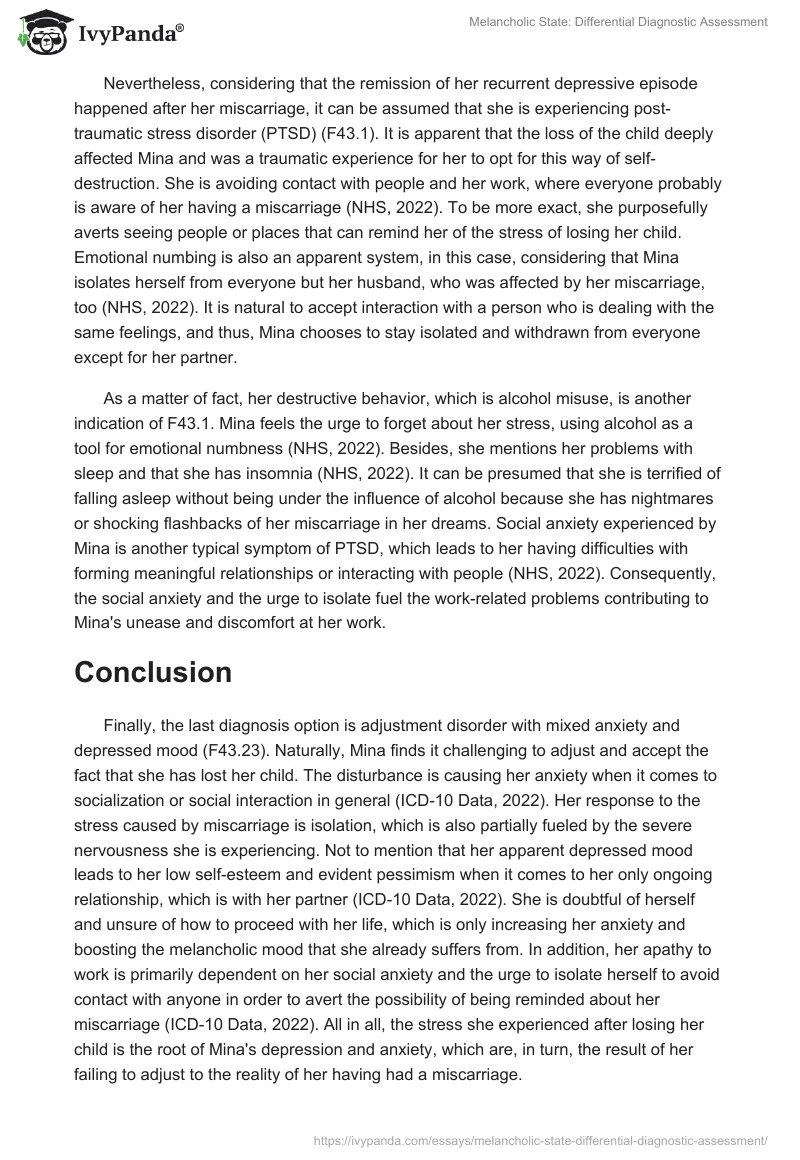Introduction
Mina’s melancholic state and apathy signal the possibility of her experiencing a depressive episode. In fact, as her husband mentions that his wife already had such episodes before, this depressive disorder can be classified as recurrent and currently in full remission (according to IDC-10 Data (2022), code F33.42). Several clinical symptoms include feelings of grief and sadness (ICD-10 Data, 2022). Besides, it can be noted that Mina has difficulties dealing with her life in terms of her following her daily routine. In other words, she cannot be active or present at her work, which leads to her staying at home because of her melancholy. Furthermore, Mina mentions that she feels like a burden to her husband, which indicates another symptom of F33.42, which is worthlessness and hopelessness.
Discussion
Not to mention that her inactivity related to her not going to work and doing nothing at home is another symptom of a depressive episode. She is not interested in anything that happens around her and her life, specifically. What is more, her flow of thoughts is likely slower due to her diminished ability to think (ICD-10 Data, 2022). As a result, she takes a long time to answer simple questions asked by the GP. Naturally, the loss of a child results in her feeling grief about her miscarriage (ICD-10 Data, 2022). On top of that, it is highlighted that she and her husband have been trying to have a child for a long time, and after finally succeeding, this loss affected Mina strongly. However, Mina’s depression episode is fueled by her feeling lonely, which is, as it appears, a typical feeling for her (ICD-10 Data, 2022). It is stated that because of her not having friends, she feels worthless and useless, but in fact, she has felt such a way for a long time. Mina has issues forming new connections, and it was probably one of the reasons for her past depression episodes and this current one.
Nevertheless, considering that the remission of her recurrent depressive episode happened after her miscarriage, it can be assumed that she is experiencing post-traumatic stress disorder (PTSD) (F43.1). It is apparent that the loss of the child deeply affected Mina and was a traumatic experience for her to opt for this way of self-destruction. She is avoiding contact with people and her work, where everyone probably is aware of her having a miscarriage (NHS, 2022). To be more exact, she purposefully averts seeing people or places that can remind her of the stress of losing her child. Emotional numbing is also an apparent system, in this case, considering that Mina isolates herself from everyone but her husband, who was affected by her miscarriage, too (NHS, 2022). It is natural to accept interaction with a person who is dealing with the same feelings, and thus, Mina chooses to stay isolated and withdrawn from everyone except for her partner.
As a matter of fact, her destructive behavior, which is alcohol misuse, is another indication of F43.1. Mina feels the urge to forget about her stress, using alcohol as a tool for emotional numbness (NHS, 2022). Besides, she mentions her problems with sleep and that she has insomnia (NHS, 2022). It can be presumed that she is terrified of falling asleep without being under the influence of alcohol because she has nightmares or shocking flashbacks of her miscarriage in her dreams. Social anxiety experienced by Mina is another typical symptom of PTSD, which leads to her having difficulties with forming meaningful relationships or interacting with people (NHS, 2022). Consequently, the social anxiety and the urge to isolate fuel the work-related problems contributing to Mina’s unease and discomfort at her work.
Conclusion
Finally, the last diagnosis option is adjustment disorder with mixed anxiety and depressed mood (F43.23). Naturally, Mina finds it challenging to adjust and accept the fact that she has lost her child. The disturbance is causing her anxiety when it comes to socialization or social interaction in general (ICD-10 Data, 2022). Her response to the stress caused by miscarriage is isolation, which is also partially fueled by the severe nervousness she is experiencing. Not to mention that her apparent depressed mood leads to her low self-esteem and evident pessimism when it comes to her only ongoing relationship, which is with her partner (ICD-10 Data, 2022). She is doubtful of herself and unsure of how to proceed with her life, which is only increasing her anxiety and boosting the melancholic mood that she already suffers from. In addition, her apathy to work is primarily dependent on her social anxiety and the urge to isolate herself to avoid contact with anyone in order to avert the possibility of being reminded about her miscarriage (ICD-10 Data, 2022). All in all, the stress she experienced after losing her child is the root of Mina’s depression and anxiety, which are, in turn, the result of her failing to adjust to the reality of her having had a miscarriage.
References
ICD-10 Data. (2022). 2023 ICD-10-CM diagnosis code F32.9: Major depressive disorder, single episode, unspecified. Web.
NHS. (2022). Symptoms – Post-traumatic stress disorder. nhs.uk. Web.



